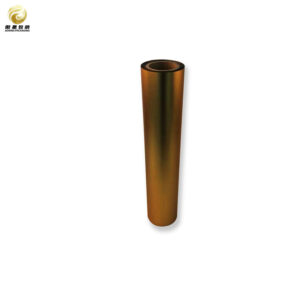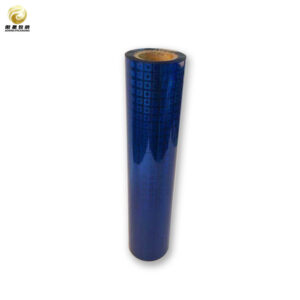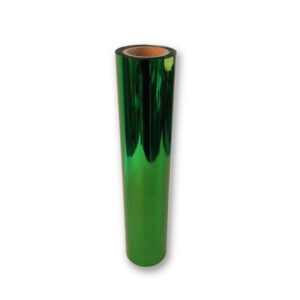Metalized polyethylene film
| Product | PET Metallized Film |
| Material | PET + color+ aluminum layer / PET + aluminum + color layer |
| Thickness | 12~188um |
| Color Option | Red,Blue,Purple,Green,Gold,Yellow,Rose,Rainbow,etc. |
| Width & Length | Width:500~1800mm Length:Customized |
Detailed Descriptions
Metalized polyethylene film is a type of packaging material that is widely used in the packaging industry. It is made by depositing a thin layer of metal, usually aluminum, onto a polyethylene film substrate. This metal layer provides the film with enhanced barrier properties, making it ideal for packaging applications where protection from moisture, oxygen, and light is crucial.
The importance of metalized polyethylene film in the packaging industry cannot be overstated. It offers a cost-effective solution for preserving the freshness and quality of various products, including food, pharmaceuticals, and electronics. With its excellent barrier properties and versatility, metalized polyethylene film has become a popular choice among manufacturers and consumers alike.
The Manufacturing Process of Metalized Polyethylene Film
The manufacturing process of metalized polyethylene film involves several key steps. First, the polyethylene film is extruded using a blown film process. This process involves melting the polyethylene resin and then blowing it into a bubble using air pressure. The bubble is then cooled and collapsed to form a flat film.
Once the polyethylene film is formed, it goes through a metallization process. In this process, the film is passed through a vacuum chamber where aluminum vapor is deposited onto its surface. The aluminum vapor condenses and forms a thin layer on the film, creating a metallic appearance.
After metallization, the metalized polyethylene film undergoes additional processes such as coating, printing, and laminating to enhance its functionality and aesthetics. These processes can include applying coatings for added protection or printing designs and information for branding purposes.
Properties and Characteristics of Metalized Polyethylene Film
Metalized polyethylene film possesses several properties and characteristics that make it an excellent choice for packaging applications.
In terms of physical properties, metalized polyethylene film has high tensile strength, which makes it resistant to tearing and puncturing. It also has good flexibility, allowing it to conform to the shape of the packaged product. Additionally, metalized polyethylene film has low moisture vapor transmission rate (MVTR), which means it provides an effective barrier against moisture.
Chemically, metalized polyethylene film is resistant to most chemicals, making it suitable for packaging products that may come into contact with corrosive substances. It is also resistant to UV radiation, which helps protect the packaged product from degradation caused by exposure to sunlight.
Mechanically, metalized polyethylene film has good heat-sealing properties, allowing it to be easily sealed using heat. This ensures the integrity of the package and prevents contamination or spoilage of the product.
Applications of Metalized Polyethylene Film in Packaging Industry
| Application | Metric |
|---|---|
| Food packaging | Barrier properties to oxygen, moisture and light |
| Pharmaceutical packaging | Protection against contamination and degradation |
| Cosmetic packaging | Enhanced shelf life and preservation of product quality |
| Industrial packaging | Resistance to punctures and tears |
| Flexible packaging | Lightweight and cost-effective alternative to rigid packaging |
Metalized polyethylene film finds a wide range of applications in the packaging industry. It is commonly used for flexible packaging of food products such as snacks, coffee, and confectionery. The film’s barrier properties help preserve the freshness and flavor of these products by preventing moisture and oxygen from entering the package.
In addition to food packaging, metalized polyethylene film is also used in pharmaceutical packaging. It provides a protective barrier against light and moisture, ensuring the stability and efficacy of pharmaceutical products. The film’s flexibility allows for easy packaging of various shapes and sizes of pharmaceutical products.
Furthermore, metalized polyethylene film is utilized in the packaging of electronics and other sensitive electronic components. Its excellent barrier properties protect these components from moisture and static electricity, preventing damage during storage and transportation.
The advantages of using metalized polyethylene film in packaging are numerous. Its lightweight nature reduces shipping costs and carbon emissions. The film’s high barrier properties extend the shelf life of packaged products, reducing waste and improving sustainability. Additionally, metalized polyethylene film is cost-effective compared to other packaging materials such as aluminum foil or metallized polyester film.
Advantages of Using Metalized Polyethylene Film in Packaging
The barrier properties of metalized polyethylene film make it an excellent choice for packaging applications. The film acts as a barrier against moisture, oxygen, and light, protecting the packaged product from degradation and spoilage. This is particularly important for perishable products such as food and pharmaceuticals, where maintaining product quality is crucial.
Another advantage of metalized polyethylene film is its cost-effectiveness. Compared to other packaging materials such as aluminum foil or metallized polyester film, metalized polyethylene film offers a more affordable option without compromising on performance. Its lightweight nature also reduces shipping costs and carbon emissions, making it an environmentally friendly choice.
Furthermore, metalized polyethylene film is known for its durability and flexibility. It can withstand rough handling during transportation and storage without tearing or puncturing. Its flexibility allows for easy packaging of various shapes and sizes of products, providing versatility to manufacturers.
Metalized Polyethylene Film vs. Other Packaging Materials
When comparing metalized polyethylene film with other packaging materials, several factors come into play. One of the main advantages of metalized polyethylene film over materials like aluminum foil is its cost-effectiveness. Metalized polyethylene film provides similar barrier properties to aluminum foil but at a lower cost, making it a more economical choice for packaging applications.
Another advantage of metalized polyethylene film is its flexibility. Unlike rigid materials such as glass or metal, metalized polyethylene film can be easily shaped and molded to fit the product being packaged. This flexibility allows for efficient use of packaging material and reduces waste.
However, it is important to note that metalized polyethylene film may not be suitable for all packaging applications. For example, if a product requires a higher level of barrier protection, materials like metallized polyester film or aluminum foil may be more appropriate. Additionally, some products may require specific properties that metalized polyethylene film cannot provide, such as high temperature resistance or transparency.
Environmental Impact of Metalized Polyethylene Film
While metalized polyethylene film offers numerous advantages in terms of performance and cost-effectiveness, it is important to consider its environmental impact. The production of metalized polyethylene film requires energy and resources, contributing to carbon emissions and resource depletion. Additionally, the disposal of metalized polyethylene film can pose challenges due to its non-biodegradable nature.
Factors contributing to the environmental impact of metalized polyethylene film include the extraction and processing of raw materials, energy consumption during manufacturing, and waste generation. These factors highlight the need for sustainable practices in the production and use of metalized polyethylene film.
Recycling and Disposal of Metalized Polyethylene Film
The recycling and disposal of metalized polyethylene film present challenges due to its complex composition. The film consists of multiple layers, including the polyethylene substrate and the thin layer of metal. Separating these layers for recycling purposes can be difficult and costly.
However, there are methods available for recycling metalized polyethylene film. One method involves shredding the film into small pieces and then using a combination of mechanical and chemical processes to separate the different components. The separated polyethylene can be recycled into new plastic products, while the metal layer can be recovered and reused.
Despite these recycling methods, the recycling rate for metalized polyethylene film remains relatively low due to the challenges involved. Improving recycling infrastructure and developing more efficient separation technologies are key areas for future development in order to increase the recycling rate of metalized polyethylene film.
Future Trends in Metalized Polyethylene Film Technology
As technology continues to advance, new trends are emerging in the field of metalized polyethylene film. One such trend is the development of thinner films with improved barrier properties. This allows for even greater cost-effectiveness and sustainability in packaging applications.
Another trend is the incorporation of additives into metalized polyethylene film to enhance its functionality. For example, antimicrobial additives can be added to the film to provide additional protection against microbial growth, extending the shelf life of packaged products.
Furthermore, there is potential for metalized polyethylene film to be used in new applications beyond traditional packaging. For instance, it could be utilized in the development of flexible electronic devices or as a component in energy storage systems. These emerging trends highlight the versatility and potential of metalized polyethylene film in various industries.
Challenges and Limitations of Metalized Polyethylene Film
While metalized polyethylene film offers numerous advantages, it also has its limitations and challenges. One limitation is its relatively low barrier properties compared to materials like aluminum foil or metallized polyester film. This means that for certain applications requiring a higher level of barrier protection, alternative materials may be more suitable.
Another challenge is the production and use of metalized polyethylene film in a sustainable manner. As mentioned earlier, the production process contributes to carbon emissions and resource depletion. Additionally, the disposal of metalized polyethylene film poses challenges due to its non-biodegradable nature.
Addressing these challenges requires a holistic approach that involves improving manufacturing processes, developing more sustainable alternatives, and promoting recycling and responsible disposal practices.
The Role of Metalized Polyethylene Film in Sustainable Packaging Solutions
In conclusion, metalized polyethylene film plays a crucial role in sustainable packaging solutions. Its barrier properties, cost-effectiveness, durability, and flexibility make it an ideal choice for various packaging applications. However, it is important to consider the environmental impact of metalized polyethylene film and work towards improving its sustainability through recycling and responsible disposal practices.
As technology continues to advance, new trends are emerging in metalized polyethylene film technology, offering even greater cost-effectiveness and functionality. Despite its limitations and challenges, metalized polyethylene film remains a valuable packaging material that contributes to the preservation of product quality and the reduction of waste in the packaging industry.
FAQs
What is metalized polyethylene film?
Metalized polyethylene film is a type of plastic film that has been coated with a thin layer of metal, usually aluminum. This coating gives the film a shiny, reflective surface that can be used for a variety of applications.
What are the benefits of using metalized polyethylene film?
Metalized polyethylene film offers several benefits, including increased durability, improved barrier properties, and enhanced visual appeal. It can also be used to reduce heat transfer and improve insulation in certain applications.
What are some common uses for metalized polyethylene film?
Metalized polyethylene film is used in a wide range of applications, including food packaging, insulation, reflective insulation, and decorative applications. It is also used in the production of solar panels and other electronic devices.
How is metalized polyethylene film made?
Metalized polyethylene film is made by coating a thin layer of metal, usually aluminum, onto a polyethylene film substrate. This is typically done using a vacuum deposition process, which involves heating the metal to a high temperature and then evaporating it onto the film surface.
What are some factors to consider when choosing metalized polyethylene film?
When choosing metalized polyethylene film, it is important to consider factors such as the intended application, the required barrier properties, and the desired level of reflectivity. Other factors to consider may include the thickness of the film, the type of metal used for the coating, and the overall cost of the material.
#!trpst#trp-gettext data-trpgettextoriginal=1975#!trpen#Productos relacionados#!trpst#/trp-gettext#!trpen#
-

#!trpst#trp-gettext data-trpgettextoriginal=1247#!trpen#Leer más#!trpst#/trp-gettext#!trpen#Matte Finish Polyester Film -

#!trpst#trp-gettext data-trpgettextoriginal=1247#!trpen#Leer más#!trpst#/trp-gettext#!trpen#Holographic Polyester Film -

#!trpst#trp-gettext data-trpgettextoriginal=1247#!trpen#Leer más#!trpst#/trp-gettext#!trpen#Transparent Polyester Roll -

#!trpst#trp-gettext data-trpgettextoriginal=1247#!trpen#Leer más#!trpst#/trp-gettext#!trpen#metalized mylar film




